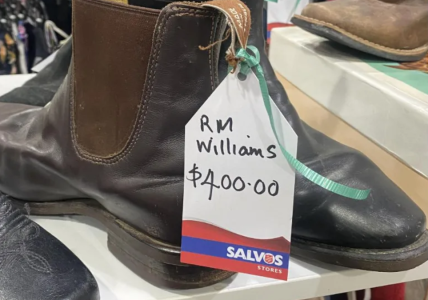Shoppers in Shock: Why This $400 Discovery at Salvos Is Causing Uproar and What It Says About a Deepening Charity Shop Crisis
By
Gian T
- Replies 45
In the midst of a cost-of-living crisis that has many Australians tightening their belts, the discovery of a pair of secondhand R.M. Williams boots priced at $400 in a Salvos store has sparked a heated debate about the pricing strategies of charity shops. This incident, which occurred in what is believed to be a Tamworth, NSW location, has left shoppers and op-shop enthusiasts feeling both outraged and betrayed.
The boots, which retail for around $649 new, were deemed 'very greedy' by many who saw the price tag as a sign of a growing problem within the charity shop sector. The image of the boots, shared online by an op-shopper, quickly became a symbol of the broader issue, with comments flooding in to express dismay and frustration.
'Daylight robbery. They get everything for free and sell for ridiculous prices. Sometimes it’s cheaper to go to Kmart,' one person argued, highlighting the irony of finding better deals at commercial retailers than in stores meant to serve those in financial need.
'They are a business now, they have forgotten people actually go there to shop because they have little money to spend. I give to the smaller charities now, they need it more,' another commented, suggesting a shift in the ethos of charity shops from community support to profit-driven enterprises.
The sentiment was echoed by others who feel that the essence of op-shopping – finding affordable secondhand goods while supporting charitable causes – is being lost. 'Salvos are getting very greedy these days,' someone else remarked, pointing to a trend that seems to be alienating the very demographic these shops were intended to serve.
In defense of the high prices, industry experts have weighed in. Andrew Hughes, a business and economics lecturer, acknowledged that charity stores are 'taking advantage of people,' given that much of their stock is donated at no cost. However, the secondhand economy is booming globally, and in Australia, for a reason. Omer Soker, CEO of Charitable Recycling Australia, attributes this to a growing interest in sustainable shopping and the prohibitive costs of new goods.
Soker also pointed to 'resellers' as the culprits behind price hikes, arguing that they purchase items from charity shops to sell at a significant markup on commercial platforms like Depop. In his view, charity shops are inadvertently acting as wholesalers, and their prices still represent good value, especially in more affluent suburbs where higher-income shoppers are willing to pay these prices. He maintains that the average cost of items across charity stores in Australia is just $5.
Yet, this defense does little to quell the concerns of regular op-shoppers and those relying on affordable secondhand goods. The issue at hand is not just about the price of a pair of boots but about the accessibility and affordability of essential items for those who are struggling financially.
As members of the Seniors Discount Club, many of us have long appreciated the value and community service provided by charity shops. They have been a staple for finding everything from clothing to household items without breaking the bank. However, when prices in these stores begin to rival those of retail outlets, it raises questions about the role and responsibility of charitable organizations in supporting the community.

We invite you to share your thoughts and experiences. Have you encountered similar pricing issues at charity shops? Do you feel that the mission of these stores is changing? And importantly, where can seniors and others on a fixed income turn to for affordable goods in these challenging times? Your insights are valuable, and together, we can continue to advocate for fair pricing and the true spirit of charity in our shopping experiences.
The boots, which retail for around $649 new, were deemed 'very greedy' by many who saw the price tag as a sign of a growing problem within the charity shop sector. The image of the boots, shared online by an op-shopper, quickly became a symbol of the broader issue, with comments flooding in to express dismay and frustration.
'Daylight robbery. They get everything for free and sell for ridiculous prices. Sometimes it’s cheaper to go to Kmart,' one person argued, highlighting the irony of finding better deals at commercial retailers than in stores meant to serve those in financial need.
'They are a business now, they have forgotten people actually go there to shop because they have little money to spend. I give to the smaller charities now, they need it more,' another commented, suggesting a shift in the ethos of charity shops from community support to profit-driven enterprises.
The sentiment was echoed by others who feel that the essence of op-shopping – finding affordable secondhand goods while supporting charitable causes – is being lost. 'Salvos are getting very greedy these days,' someone else remarked, pointing to a trend that seems to be alienating the very demographic these shops were intended to serve.
In defense of the high prices, industry experts have weighed in. Andrew Hughes, a business and economics lecturer, acknowledged that charity stores are 'taking advantage of people,' given that much of their stock is donated at no cost. However, the secondhand economy is booming globally, and in Australia, for a reason. Omer Soker, CEO of Charitable Recycling Australia, attributes this to a growing interest in sustainable shopping and the prohibitive costs of new goods.
Soker also pointed to 'resellers' as the culprits behind price hikes, arguing that they purchase items from charity shops to sell at a significant markup on commercial platforms like Depop. In his view, charity shops are inadvertently acting as wholesalers, and their prices still represent good value, especially in more affluent suburbs where higher-income shoppers are willing to pay these prices. He maintains that the average cost of items across charity stores in Australia is just $5.
Yet, this defense does little to quell the concerns of regular op-shoppers and those relying on affordable secondhand goods. The issue at hand is not just about the price of a pair of boots but about the accessibility and affordability of essential items for those who are struggling financially.
As members of the Seniors Discount Club, many of us have long appreciated the value and community service provided by charity shops. They have been a staple for finding everything from clothing to household items without breaking the bank. However, when prices in these stores begin to rival those of retail outlets, it raises questions about the role and responsibility of charitable organizations in supporting the community.
Key Takeaways
- The high cost of some secondhand items in Australian charity stores like Salvos and Vinnies has caused outrage among shoppers.
- A pair of secondhand R.M. Williams boots was priced at $400 in a Salvos store, near the new-item price of roughly $649, leading to claims of greed.
- Some shoppers have accused charity stores of becoming too business-like, forgetting their core clientele of people with limited funds.
- An industry expert defended high prices by explaining the impact of resellers on the market and claimed that the overall average cost of items in charity shops is around $5.
We invite you to share your thoughts and experiences. Have you encountered similar pricing issues at charity shops? Do you feel that the mission of these stores is changing? And importantly, where can seniors and others on a fixed income turn to for affordable goods in these challenging times? Your insights are valuable, and together, we can continue to advocate for fair pricing and the true spirit of charity in our shopping experiences.








